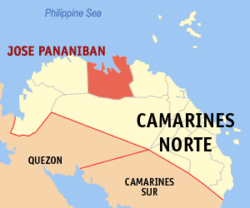Jose Panganiban Mambulao | |
|---|---|
| Municipality of Jose Panganiban | |
 View from the mountain | |
| Motto: Alay sa Diyos at sa Bayan | |
| Anthem: Mahal Kong Jose Panganiban (Mambulao Hymn) | |
 Map of Camarines Norte with Jose Panganiban highlighted | |
Location within the Philippines | |
| Coordinates: 14°17′32″N122°41′34″E / 14.2922°N 122.6928°E | |
| Country | Philippines |
| Region | Bicol Region |
| Province | Camarines Norte |
| District | 1st district |
| Founded | 1634 |
| Renamed | December 1, 1934 |
| Named after | Jose Maria Panganiban |
| Barangays | 27 (see Barangays) |
| Government | |
| • Type | Sangguniang Bayan |
| • Mayor | Ariel M. Non |
| • Vice Mayor | Casimero B. Padilla, Jr. |
| • Representative | Josefina B. Tallado |
| • Municipal Council | Members |
| • Electorate | 35,758 voters (2025) |
| Area | |
• Total | 214.44 km2 (82.80 sq mi) |
| Elevation | 43 m (141 ft) |
| Highest elevation | 277 m (909 ft) |
| Lowest elevation | 0 m (0 ft) |
| Population (2024 census) [3] | |
• Total | 60,626 |
| • Density | 282.72/km2 (732.24/sq mi) |
| • Households | 14,560 |
| Economy | |
| • Income class | 2nd municipal income class |
| • Poverty incidence | 26.38 |
| • Revenue | ₱ 307.6 million (2022) |
| • Assets | ₱ 739.5 million (2022) |
| • Expenditure | ₱ 168 million (2022) |
| • Liabilities | ₱ 143.7 million (2022) |
| Service provider | |
| • Electricity | Camarines Norte Electric Cooperative (CANORECO) |
| Time zone | UTC+8 (PST) |
| ZIP code | 4606 |
| PSGC | |
| IDD : area code | +63 (0)54 |
| Native languages | |
| Website | mambulao |
Jose Panganiban, officially the Municipality of Jose Panganiban (Tagalog : Bayan ng Jose Panganiban), is a municipality in the province of Camarines Norte, Philippines. According to the 2020 census, it has a population of 63,662 people. [5]
Contents
- Etymology
- History
- Geography
- Barangays
- Climate
- Demographics
- Economy
- Mining
- Jose Panganiban Special Economic Zones
- Tourism
- Historical landmarks
- Islands and beach destinations
- Other local spots
- Infrastructure
- Airport and Seaports
- Public Land Transportation
- Electricity and Water Supply
- Communication
- Medical Institutions
- Education
- Primary and elementary schools
- Private Schools
- Secondary schools
- Higher educational institutions
- Media
- Radio stations
- Sister cities
- Gallery
- Notable
- See also
- References
- External links












